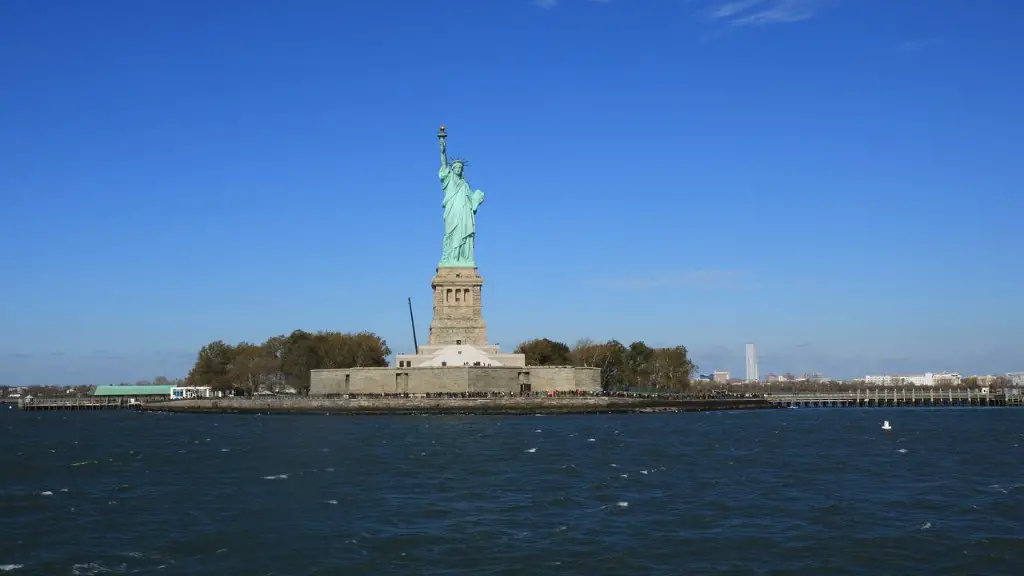Architecture of Sagrada Familia
The Sagrada Familia, located in Barcelona, Spain, is one of the world’s most famous and iconic works of architecture. The church, designed by Catalan architect Antoni Gaudí, has been under construction since 1882 and is scheduled to be completed in 2026. While the Sagrada Familia has been under construction for over a century, when did building on it actually start?
When designing the Sagrada Familia, Gaudí drew inspiration from the Gothic cathedral designs of the past. He implemented a range of techniques to create a more modern design, including the use of reinforced concrete and a complex system of buttresses for stability. Gaudí also incorporated triangular spires and distinctive chimneys.
Construction of the Sagrada Familia began in 1882. Gaudí was appointed as the project’s lead architect in 1883 and took full control of the project. He spent over forty years of his life working on the church and overseeing its construction. Gaudí made use of modern construction techniques and materials, but also incorporated traditional glazing and stone carving techniques, resulting in a unique and innovative style of architecture.
The construction of the Sagrada Familia has been ongoing for over 135 years, and it has been estimated that it will take another 10 years to complete. This reflects the complexity of the church’s design and the amount of detail required to create such an iconic landmark. Gaudí was closely involved in the design of the Sagrada Familia until his death in 1926, overseeing the construction and ensuring that it was built according to his vision.
Experts believe that due to the complexity of the building, it is impossible to build the Sagrada Familia in a modern era. Its construction methods require expert and experienced craftspeople, and many of the techniques and materials used are no longer available or in use today. The Sagrada Familia is an impressive example of the power of architecture. Its construction over such a long period of time has resulted in a truly unique and beautiful building that stands out from other landmarks in the world.
Contribution of Antoni Gaudí
Antoni Gaudí was born in 1852 and was a renowned Catalan architect who was known for his unique, Art Nouveau-influenced architecture. He is widely considered to be one of the greatest architects of the late 19th and early 20th centuries. He is best known for his work on the Sagrada Familia, regarded as his magnum opus, as well as Casa Battló and Park Güell. Gaudí was also known for his unconventional use of materials and his unconventional approach to architecture, which combined a complex array of geometric forms.
Gaudí was appointed as the lead architect of the Sagrada Familia in 1883 and worked on the church until his death in 1926. He made use of innovative construction techniques, materials and decoration, as well as traditional elements, to create a building that is truly unique. Gaudí used a variety of materials in the construction of the Sagrada Familia, including stone, iron, glass, ceramic and concrete. He also made use of a range of geometric shapes, such as parabolas, hyperbolas and spirals, to create a sense of dynamism in the structure.
Gaudí’s involvement in the Sagrada Familia was paramount in its construction and in the development of its unique design. He envisioned it to be a modern interpretation of a Gothic cathedral, and worked to ensure that it was built according to his artistic vision. His influence on the Sagrada Familia can still be felt today, as much of his original design remains unchanged.
Gaudí’s work on the Sagrada Familia reflected his distinctive style of architecture, which combined traditional and modern elements. The building is an impressive example of Art Nouveau-influenced architecture, and his innovative use of materials and techniques have ensured that it continues to stand as an iconic landmark in Barcelona.
Components of the Sagrada Familia
The Sagrada Familia is a Gothic-style cathedral that is composed of a variety of architectural elements. The building consists of three main components: the nave, the choir and the apse. The nave is the main body of the building and consists of a central aisle flanked by two lower aisles. The choir is located at the east end of the nave and consists of two rows of seating, along with a raised altar. The apse is located at the end of the choir and is composed of a semi-circular space, flanked by two transepts.
The building also includes a number of other components, such as two bell towers and four smaller, flanking towers. In addition, the Sagrada Familia is adorned with a variety of sculptures, stained glass windows and mosaics, many of which were designed by Gaudí. Gaudí’s architectural style is also evident in the building’s overall form and structure. The design is asymmetrical and incorporates a variety of geometric shapes and lines, giving the structure a unique and dynamic feel.
The Sagrada Familia is also renowned for its intricate and detailed façade designs. The façades are composed of a variety of richly-detailed sculptures, mosaics and stained glass windows, providing a visually stunning contrast to the simple and symmetrical forms of the nave and apse. Gaudí’s façades also incorporate a variety of religious symbols and imagery, adding to the building’s overall spiritual and cultural significance.
The building is also unique in that its construction has been ongoing for over a century, and is not yet complete. This adds to the significance of the building and adds to the overall mystery and intrigue of the structure. The long history of the Sagrada Familia and the enduring legacy of Gaudí have contributed to its popularity and have ensured that it continues to be one of the world’s most iconic works of architecture.
Symbolism of Sagrada Familia
The Sagrada Familia is a unique example of Gothic and Art Nouveau-inspired architecture, and is renowned for its intricate and lavish decorations. The building’s design includes a variety of religious symbols and icons, which Gaudí included in an effort to create a more spiritual and meaningful structure. The façades of the building portray a variety of biblical stories and images, providing viewers with a variety of interpretations.
The primary façade of the building, the Nativity Façade, is the first part of the building to be completed and provides viewers with a scene from the nativity story. Other façades, such as the Passion Façade and the Glory Façade, depict scenes from the life and passion of Jesus, as well as scenes from the afterlife. Gaudí also included a variety of symbols in the building’s design, such as the cross, the dove and the star of David, which further contribute to the overall symbolism of the building.
The building’s symbolism reflects Gaudí’s own spiritual beliefs, in particular his belief in the divine connection of humanity. His unique style of architecture reflects the importance of spirituality in his work and reflects the importance of religion in his life. The building also reflects Gaudí’s belief in the power of art and architecture to evoke strong emotions and stir spiritual feelings in viewers.
The Sagrada Familia is renowned for its unique design and its intricate decorations, and it has become an iconic landmark in Barcelona. Its symbolism and meaning are intertwined with the history of the city and its people, and it stands as a testament to the power and importance of art, architecture and religion.
The Construction Process
The construction of the Sagrada Familia has been ongoing for over a century and it is expected to take another 10 years to complete. This reflects the complexity of the church’s design and the amount of detail required to create such an iconic landmark. The construction of the Sagrada Familia has been carried out by a variety of craftsmen and construction workers, and has relied upon a range of traditional and modern construction techniques and materials.
Gaudí was heavily involved in the construction process and designed the building using a combination of traditional and modern techniques. He employed a range of expert craftsmen, such as stone carvers and glaziers, to ensure that the building was constructed to the highest standard. Gaudí also employed a range of innovative materials, such as concrete and iron, which helped to ensure the stability of the structure.
The building’s construction has been ongoing for over 135 years and it is estimated that it will take another 10 years to complete. During this time, the building has undergone a number of changes and renovations, as Gaudí and his successors have often made changes and improvements to the design. Despite these changes, much of Gaudí’s original vision has remained intact.
The Sagrada Familia is an impressive example of the power of architecture. Its construction over such a long period of time has resulted in a truly unique and beautiful building, which stands out from other landmarks in the world. Despite its long construction timeline, the Sagrada Familia has remained a symbol of hope, faith and perseverance.
Legacy of the Sagrada Familia
The Sagrada Familia is one of the most iconic and beloved landmarks in Barcelona. It has become a symbol of the city and has become a popular attraction for both locals and visitors alike. The building’s unique design and its long construction timeline have helped to ensure that it remains an important part of the city’s culture and history.
The Sagrada Familia has become a symbol of hope and faith for many, as its construction has been ongoing for over a century. Its construction has been a lengthy and often difficult process, yet it stands as a testament to the power of hard work and perseverance. The building has also become a symbol of spirituality, as its intricate design and decorations reflect Gaudí’s dedication to his faith and his desire to create a modern interpretation of a Gothic cathedral.
The Sagrada Familia is also a symbol of Antonio Gaudí’s illustrious career and his unparalleled contribution to the world of architecture. Gaudí devoted his life to the construction of the church, overseeing the building and ensuring that it was built according to his vision. Gaudí’s influence on the Sagrada Familia can still be felt today, as much of his original design remains unchanged.
The Sagrada Familia will remain an iconic landmark in Barcelona and a symbol of hope, faith and perseverance for generations to come. Its history, symbolism and architecture will continue to inspire visitors from all over the world and will remain one of the world’s most impressive and iconic works of architecture.

